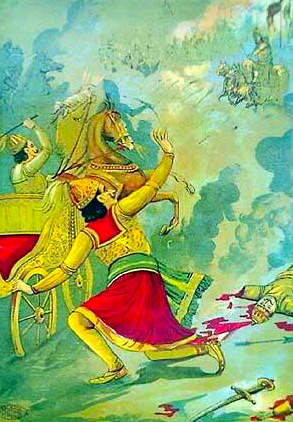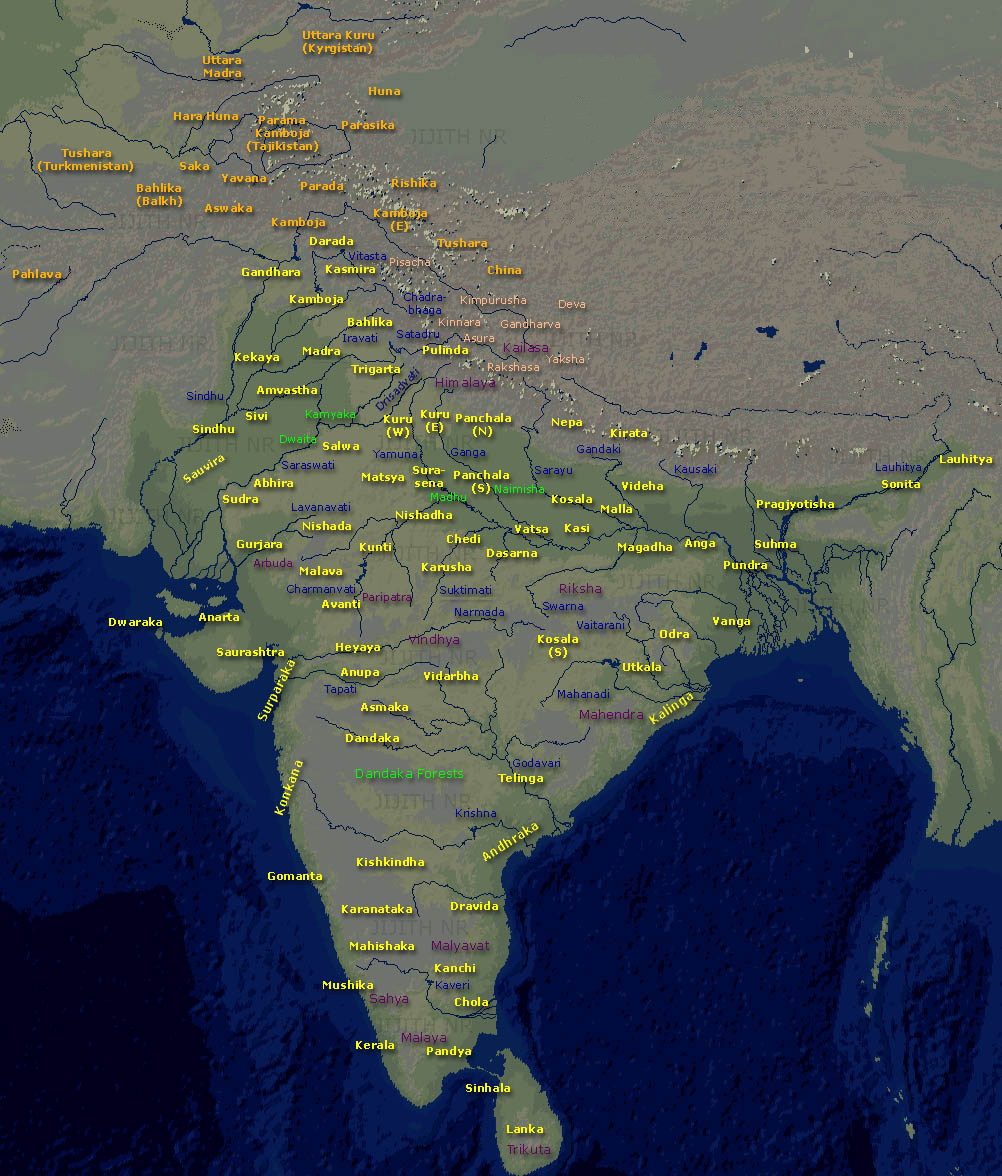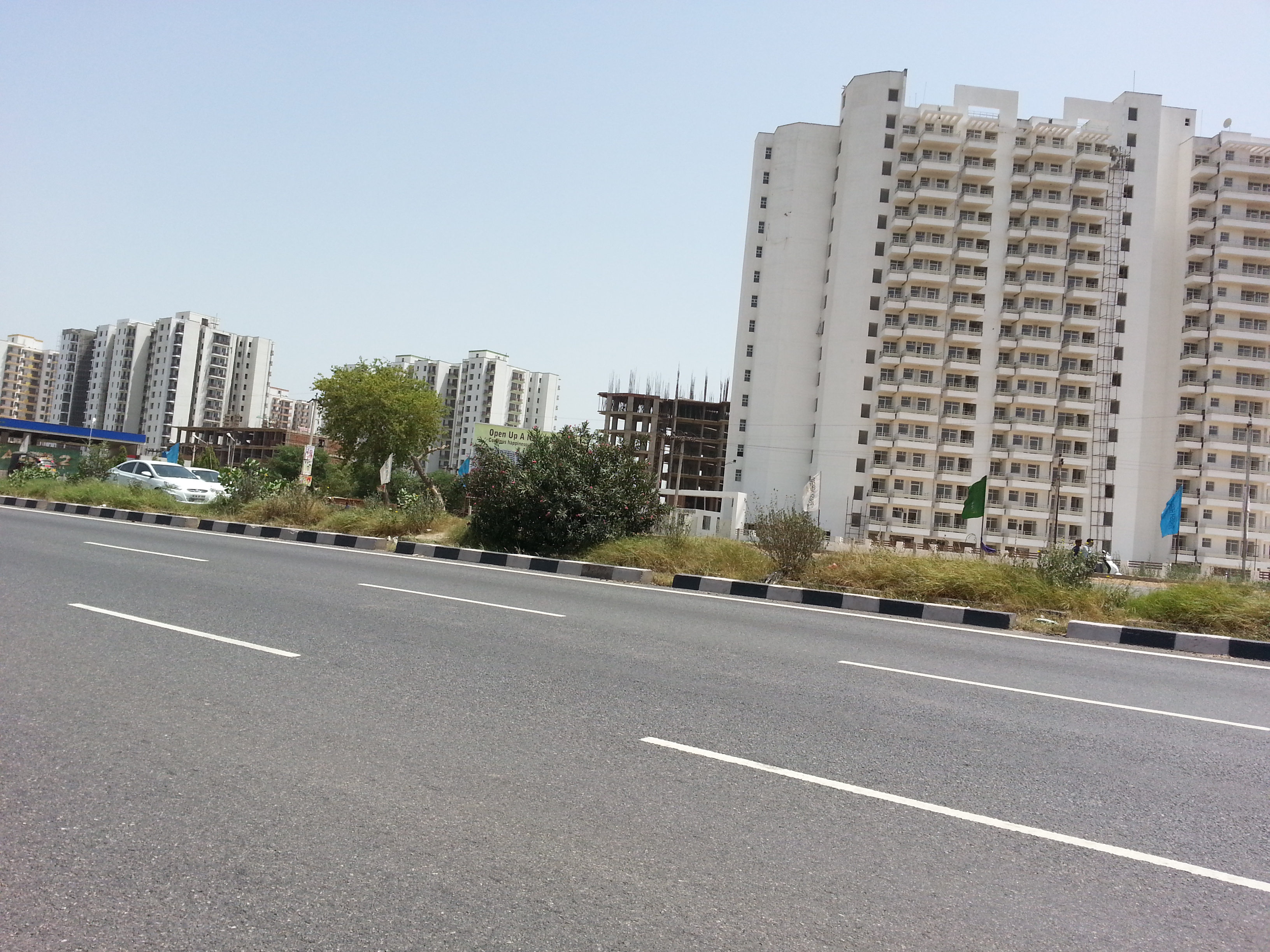|
Salva (India)
The Salva or Salvi tribe is mentioned in Late Vedic texts (such as the Jaiminiya Brahmana) is a tribe that invaded Kurukshetra and defeated the Kuru kingdom, probably 900 BCE. The prior history of the Salva tribe is obscure, although they appear to have been associated with the Trigarta kingdom and the Punjab region. After invading the Kuru kingdom, the Salvas settled along the Yamuna river and the Alwar region of Rajasthan (near the Matsya kingdom), and by the end of the Vedic period they had eventually adopted Vedic culture as they coalesced with the remaining Kurus and the Surasena mahajanapada. A passage in the Karna Parva of the Mahabharata praises the Salvas for following the "eternal law of righteousness" but also says that they "need full instruction," unlike the more perceptive Kurus and Panchala Panchala () was an ancient kingdom of northern India, located in the Ganges-Yamuna Doab of the Upper Gangetic plain which is identified as Kanyakubja or region a ... [...More Info...] [...Related Items...] OR: [Wikipedia] [Google] [Baidu] |
Vedic Period
The Vedic period, or the Vedic age (), is the period in the late Bronze Age and early Iron Age of the history of India when the Vedic literature, including the Vedas (–900 BCE), was composed in the northern Indian subcontinent, between the end of the urban Indus Valley Civilisation and a second urbanisation, which began in the central Indo-Gangetic Plain BCE. The Vedas are liturgical texts which formed the basis of the influential Brahmanical ideology, which developed in the Kuru Kingdom, a tribal union of several Indo-Aryan tribes. The Vedas contain details of life during this period that have been interpreted to be historical and constitute the primary sources for understanding the period. These documents, alongside the corresponding archaeological record, allow for the evolution of the Indo-Aryan and Vedic culture to be traced and inferred. The Vedas were composed and orally transmitted with precision by speakers of an Old Indo-Aryan language who had migrated into ... [...More Info...] [...Related Items...] OR: [Wikipedia] [Google] [Baidu] |
Rajasthan
Rajasthan (; Literal translation, lit. 'Land of Kings') is a States and union territories of India, state in northwestern India. It covers or 10.4 per cent of India's total geographical area. It is the List of states and union territories of India by area, largest Indian state by area and the List of states and union territories of India by population, seventh largest by population. It is on India's northwestern side, where it comprises most of the wide and inhospitable Thar Desert (also known as the Great Indian Desert) and shares a border with the Pakistani provinces of Punjab, Pakistan, Punjab to the northwest and Sindh to the west, along the Sutlej-Indus River valley. It is bordered by five other Indian states: Punjab, India, Punjab to the north; Haryana and Uttar Pradesh to the northeast; Madhya Pradesh to the southeast; and Gujarat to the southwest. Its geographical location is 23°3' to 30°12' North latitude and 69°30' to 78°17' East longitude, with the Tropic of Can ... [...More Info...] [...Related Items...] OR: [Wikipedia] [Google] [Baidu] |
Sial Tribe
The Sial or Siyal ( Punjabi and Urdu: سيال) is a Punjabi clan found in the Punjab region of the Indian subcontinent, split between India and Pakistan. Ethnographic classification According to the Bardic traditions, Sials descended from a certain Rai Shankar, a Parmar Rajput. Rai Shankar had three sons: Seo, Teo and Gheo, the ancestors of Sial, Tiwana and Gheba clans, respectively. Denzil Ibbetson, an administrator of the British Raj, classified the Sial as a Rajput tribe. However, they are also classified as Jats. Following the introduction of the Punjab Land Alienation Act in 1900, the authorities of the Raj classified the Sials who inhabited the Punjab as an "agricultural tribe", a term that was administratively synonymous with the " martial race" classification that was used for the purposes of determining the suitability of a person as a recruit to the British Indian Army. History During the fifteenth- and sixteenth-century periods of the Mughal Empire, t ... [...More Info...] [...Related Items...] OR: [Wikipedia] [Google] [Baidu] |
Keśin Dālbhya
Keśin Dālbhya (or Dārbhya) was a king of Panchala during the Late Vedic period, most likely between 900 and 750 BCE. Historical Mentions He is mentioned prominently in the Taittiriya and Jaiminiya Brahmanas. His maternal uncle was a Kuru king, reflecting the matrimonial alliance between the two kingdoms. His reign saw the establishment of the Panchala kingdom as the dominant political and cultural center of northern India, in the aftermath of the decline and defeat of the Kuru Kingdom by the non-Vedic Salva tribe. The nephew of the Kuru king Ucchaisravas, son of Kuvaya, who had died heirless, he subsequently took over the leadership and ensured the continuation of the Vedic tradition. His dynasty remained in power for many generations; one of his later successors was the philosopher-king Pravahana Jaivali mentioned in the Upanishads. See also *Parikshit *Janaka Janaka (, IAST: ''Janaka'') is the King of Videha who ruled from Mithila (region), Mithila, in ... [...More Info...] [...Related Items...] OR: [Wikipedia] [Google] [Baidu] |
Panchala
Panchala () was an ancient kingdom of northern India, located in the Ganges-Yamuna Doab of the Upper Gangetic plain which is identified as Kanyakubja or region around Kannauj. During Late Vedic times (c. 1100–500 BCE), it was one of the most powerful states of ancient India, closely allied with the Kuru Kingdom. By the c. 5th century BCE, it had become an oligarchic confederacy, considered one of the ''solasa'' (sixteen) mahajanapadas (major states) of the Indian subcontinent. After being absorbed into the Mauryan Empire (322–185 BCE), Panchala regained its independence until it was annexed by the Gupta Empire in the 4th century CE. Location The Pañcāla state was located to the west of the Gomti river, and the north of the Chambal River. Its western neighbours were the Sūrasenas and the Yakṛllomas, while in the north-west it was separated from the Gaṅgā and the Kurus by dense forests. The northern boundaries of Pañcāla were the forests around the reg ... [...More Info...] [...Related Items...] OR: [Wikipedia] [Google] [Baidu] |
Mahabharata
The ''Mahābhārata'' ( ; , , ) is one of the two major Sanskrit Indian epic poetry, epics of ancient India revered as Smriti texts in Hinduism, the other being the ''Ramayana, Rāmāyaṇa''. It narrates the events and aftermath of the Kurukshetra War, a war of succession between two groups of princely cousins, the Kauravas and the Pandava, Pāṇḍavas. It also contains Hindu philosophy, philosophical and devotional material, such as a discussion of the four "goals of life" or ''puruṣārtha'' (12.161). Among the principal works and stories in the ''Mahābhārata'' are the ''Bhagavad Gita'', the story of Damayanti, the story of Shakuntala, the story of Pururava and Urvashi, the story of Savitri and Satyavan, the story of Kacha (sage), Kacha and Devayani, the story of Rishyasringa and an Ramopakhyana, abbreviated version of the ''Rāmāyaṇa'', often considered as works in their own right. Traditionally, the authorship of the ''Mahābhārata'' is attributed to Vyasa, Vy ... [...More Info...] [...Related Items...] OR: [Wikipedia] [Google] [Baidu] |
Karna Parva
The Karna Parva () ("Book of Karna") is the eighth of the eighteen ''parvas'' (books) of the Indian epic ''Mahabharata''. Karna Parva traditionally has 96 chapters.Ganguli, K.M. (1883-1896)Karna Parva in ''The Mahabharata of Krishna-Dwaipayana Vyasa'' (12 Volumes). CalcuttaDutt, M.N. (1901) ''The Mahabharata (Volume 8): Karna Parva''. Calcutta: Elysium Press The critical edition of Karna Parv has 69 chapters Karna Parva describes the appointment of Karna as the third commander-in-chief of the Kaurava alliance. The Parva recites how war begins to tire and frustrate everyone. This book describes how brutal war leads to horrifying behavior over the 16th and 17th day of the 18-day Kurukshetra War. Karna Parva includes a treatise by Aswatthama which focuses on the motive of the deeds of human life. The crowning incident of this Parva is the final confrontation between Karna and Arjuna, in which Karna is killed.Bibek Debroy (2013), The Mahabharata, Volume 7, Penguin, , Section 73 - Ka ... [...More Info...] [...Related Items...] OR: [Wikipedia] [Google] [Baidu] |
Mahajanapada
The Mahājanapadas were sixteen kingdoms and aristocratic republics that existed in ancient India from the sixth to fourth centuries BCE, during the second urbanisation period. History The 6th–5th centuries BCE are often regarded as a major turning point in early Indian history. During this period, India's first large cities since the demise of the Indus Valley civilization arose. It was also the time of the rise of sramana movements (including Buddhism and Jainism), which challenged the religious orthodoxy of the Vedic period. Two of the Mahājanapadas were most probably s (aristocratic republics), and others had forms of monarchy. Ancient Buddhist texts like the '' Anguttara Nikaya'' make frequent reference to sixteen great kingdoms and republics that had developed and flourished in a belt stretching from Gandhara in the northwest to Anga in the east to Asmaka in the southern part of the Indian subcontinent. They included parts of the trans- Vindhyan region, and ... [...More Info...] [...Related Items...] OR: [Wikipedia] [Google] [Baidu] |
Surasena
The kingdom of Surasena () was an ancient Indian region corresponding to the present-day Braj region in Uttar Pradesh, with Mathura as its capital city. According to the Buddhist text '' Anguttara Nikaya'', Surasena was one of the sixteen Mahajanapadas (lit. 'great realms') in the 6th century BCE. Also, it is mentioned in the Hindu epic poem Ramayana. The ancient Greek writers (e.g., Megasthenes) refer to the Sourasenoi and its cities, Methora and Cleisobra/Kleisobora . Location The Śūrasena state was located on the Yamunā river, and its capital was the city of Mathurā. Origin It is speculated that the Surasena kingdom was established by Šúraséna on the banks of Saraswati. The Surasenas claimed their descent from the Yadus mentioned in the Rigveda. Surasena was one of the sixteen Mahajanapadas. The Sura-sena Janapada was occupied by Vrishnis and Andhakas, branches of the Yadu tribe. History The Mahabharata and the Puranas refer to the rulers of the Mathura regi ... [...More Info...] [...Related Items...] OR: [Wikipedia] [Google] [Baidu] |
Matsya Kingdom
Matsya () was a Vedic kingdom and later became a part of sixteen Mahajanapadas, which also appears in Hindu Epic literature. The capital of Matsya was at Viratanagari (present-day Bairat, in Rajasthan) which is said to have been named after its founder king, Virata. Mention in Mahabharata Matsya kingdom was founded by king Matsya who was the twin brother of Satyavati Satyavati (, ; also spelled Satyawati) was the queen of the Kuru Kingdom in the Hindu epic ''Mahabharata''. Satyavati is married to king Shantanu of Hastinapura, and is a great-grandmother of the Pandava and Kaurava princes. She is also the m ... and who was contemporary to Bhishma. References Kingdoms in the Mahabharata {{Hindu-myth-stub ... [...More Info...] [...Related Items...] OR: [Wikipedia] [Google] [Baidu] |
Alwar
Alwar ( Rajasthani Pronunciation: �lʋəɾ is a city located in India's National Capital Region (NCR) and the administrative headquarters of Alwar District in the state of Rajasthan. It is located 150 km south of Delhi and 150 km north of Jaipur. Etymology There are several theories about the derivation of the name Alwar. Alexander Cunningham, the British Indian archeologist, believed that the city derived its name from the Salva tribe and was originally Salwapur, then Salwar, Halawar and eventually Alwar, According to another school it was known as Aravalpur or the city of Aravali. Some others opine that the city is named after Khanzada Alawal Khan Mewati (the Muslim Khanzada prince who wrested Alwar from Nikumbh Rajputs). A research conducted during the reign of Maharaja Jai Singh of Alwar revealed that Maharaja Alaghraj, second son of Maharaja Kakil of Amber. ruled the area in the eleventh century and his territory extended up to the present city of Alwar ... [...More Info...] [...Related Items...] OR: [Wikipedia] [Google] [Baidu] |
Jaiminiya
The ''Samaveda'' (, , from '' सामन्'', "song" and ''वेद'', "knowledge"), is the Veda of melodies and chants. It is an ancient Vedic Sanskrit text, and is one of the sacred scriptures in Hinduism. One of the four Vedas, it is a liturgical text which consists of 1,875 verses. All but 75 verses have been taken from the Rigveda. Three recensions of the ''Samaveda'' have survived, and variant manuscripts of the Veda have been found in various parts of India. While its earliest parts are believed to date from as early as the Rigvedic period, the existing samhita text dates from the post-Rigvedic Mantra period of Vedic Sanskrit, between c. 1200 and 1000 BCE or "slightly rather later," roughly contemporary with the Atharvaveda and the Yajurveda. Along with the Samhita layer of text, the ''Samaveda'' includes Brahmana texts, and a final layer of the text that covers philosophical speculations (Upanishads). These layers of the compilation date from the post-Rigvedic Mant ... [...More Info...] [...Related Items...] OR: [Wikipedia] [Google] [Baidu] |







